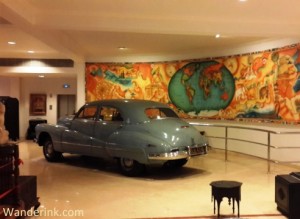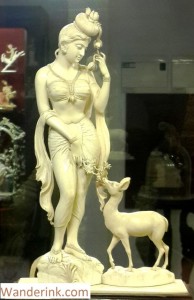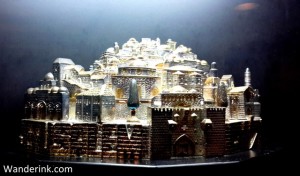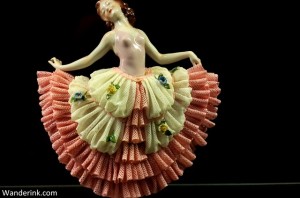The once-happening entrepot Alleppey in Kerala is popular today for backwaters, boat races and beaches, houseboats and homestays. Its immense historicity has been relegated to some sprawling warehouses bearing Victorian names and presiding over hyacinth-laden canals, a handful of ancient temples and a vastly retrenched coir industry. Missing from the milieu of ‘modern’ experiences was the museum – both as a beacon to an era past and a sensory-offensive like the V&A with its mind-dazzling array of decorative arts. The existence of the ‘crystal museum’ as it is commonly known thus came as both a surprise and relief.
“There is no such museum.” The autorickshaw guy assured us at a busy intersection, one wary eye on the traffic signal. Luckily a wrinkly hand shot out from the tarpaulined dark of the backseat and thwacked him across the back of his head.
“What do you have in your head? Cow dung?” Point made, an ammachi with wide, mischievous eyes behind shell-frame eyewear proceeded to give us the directions. The driver kept an averted gaze, having decidedly found the downpour more interesting.
The Revi Karuna Karan Museum is among the biggest privately held collection of crystals in the world but has managed to tuck itself away within an oyster shell of anonymity for nearly a decade. Even though I hail from the neighbouring district of Kottayam and over the past years as a resident of Delhi have come again for at least three instalments of the annual Nehru Trophy spectacle as a tourist propah, it was only recently I came to know about it. But from a very likely source – my mother. Like most women in the world she lusts after Lalique and Lladro and goes moony over Moser. And I suspect for a piece of Swarovski she’d happily disown me. There are plenty of these at the RKK Museum.
One of the reasons why not many know of this glittery cornucopia is a telling pointer to the evanescence of tourism ethos that historically marked Kerala’s hospitality culture itself – the generosity and contentment that came from giving gratification, treating the guest as god. “The cabbies ask for commission to bring tourists,” says Suraj who shows visitors around the museum. “We do not subscribe to such under-the-belt tactics to bolster footfalls nor do we believe in blowing our own trumpet.” Betty, who founded the museum in the memory of her late husband Revi is also sure that the museum need be visited only by the discerning, those genuinely interested in art and heritage and of course crystals and serious watchers of beau monde legacies.
It all began with the Hedgehog almost a quarter of a century ago. Compulsive world trippers as Betty (real name ‘Subhadra’) and Revi were, it was during one of their international sojourns in 1982 that this spiny, shiny creation became Betty’s first crystal possession. Five years later when Swarovski formed the Swarovski Crystal Society she was one of the first to sign up. Over the years her collection grew to nearly 1,000 pieces which includes some of the rarest Swarovski ever made: the Silver Crystal Mouse which was the first ever figurine in the brand’s silver crystal collection, a coffee bean grinding machine – one of the two ever produced (the other one is in the company museum in its headquarters in Wattens, Germany) and a crane which is one of the only three pieces ever made – a gift from the company when the museum opened in 2006. The limited edition pieces – made for SCS members numbering just three lakh all over the world – made annually have also found their way into the museum. Of these, the India-inspired items are not merely exotic but exceedingly gorgeous probably for their familiarity – the sinewy tiger Sabu and this year’s theme, the peacock Arya of the most flamboyant green you’d ever see. In addition to Swarovski, the museum also flaunts some of the most dazzling creations from Daum, Desna, Stuben and Tiffany. On the first floor of the museum you realise all that really glitters got to be crystal and maybe they’re all here.
Setting the tone for the collectibles rare and extraordinary – not to mention exorbitantly expensive – is ‘The Prodigal Son’ a seven-footer in bronze by the celebrated Israeli sculptor Sam Philipe. Although this was a gift from Pave the Way Foundation, which aims to, among other things, remove all non-theological obstacles between faiths, the museum boasts many more of the widely acclaimed creations by Philipe including ‘Old Jerusalem’ in silver and gold, ‘Abraham’s Sacrifice’ and a haunting depiction of a Holocaust survivor, a child, clinging onto her meagre worldly possessions and maybe the last vestiges of her innocence. The ‘Madonna and Baby Jesus’ is one of the seven pieces by the sculptor and the story goes that Betty had to really put her foot down to procure this one. Finally Philipe himself intervened and brought it over to Kerala personally.
The centrepiece of the grandeur on the ground floor is without doubt the Buick Super. The C-body with a straight-eight engine was a legend in its own time; now preserved in pristine condition. Though requests for a peek under the hood are turned down, we are assured that it is still up for a spin preferably on a clear day. Magnificent Tanjore paintings and a door frame with some of the finest intricate carvings on the lintel are among the highlights here. Towards the right side of the hall are family photographs with some relevant history. Revi’s grandfather Krishnan was a doyen of the coir industry in Kerala and was also the first Indian to establish a handloom factory which was a monopoly of the English. Besides attending to the rigorous needs of a burgeoning business, Krishnan took time out to collect and preserve whatever items that caught his fancy. Among others the Nettoor Petti, Theyyam headgear, an Aranmula Mirror slightly sub-fusc from old age, a single-occupant canoe all preserved in the Kerala section point to a mind keen on preserving traditions and culture. “It is not just great joy and pride but I am awash with absolute respect for my ancestors when I see these,” says Betty.
The ivory scrimshaws on the first floor are also one of the largest individually owned collections in the world. Besides the numerous religious icons rendered in tusk, the one of Shakuntala by artist Vishwam who won the President’s Award for the creation will take your breath away. A refreshing take on the babe in the woods – with another doe-eyed denizen of the forest. Giving contest to the contours of Shakuntala are the nude Ethiop figurines by Lladro in porcelain. Other truly breathtaking artistry courtesy of Dresden, Meissen, Rosenthal, Limoges line the shelves – floral awnings with birds perched on top, gambolling couples, picnicking women with parasols, bedecked chariots, Ganesha, Lakshmi and Shiva.
An oxide-paved corridor – traditional Kerala – takes one to the state gallery and on to the hall with the Sam Philipe works. Another section of the hall houses travel knickknacks from Revi and Betty’s trips like liquor flasks given by KLM. At least a hundred of them featuring traditional Holland houses are lined up unopened – from the numerous trips made in the ‘Royal Dutch Airlines’; Revi’s mother was German.
“They didn’t get the tiles like we did,” I tch-ed to mom, reminiscing our own early flights.
“The liquor flasks are for first class fliers,” Suraj said. “But there are some tiles too,” he added with a striking politeness.
The guy on the Mayan calendar stuck his tongue out probably chagrined at the turn of events. I guess I knew how he felt.
More useful museum details
Timings: 9 AM to 5 PM; Tuesday to Sunday
Entry fee: Rs 150 for Indians; Rs 350 for foreigners
Tip: The museum staff will not switch on air conditioning unless specifically requested.




















Never knew of such a museum! Thanks for this gem of an information, would love to check it out whenever I get a chance to visit Alleppey next.
You are welcome!